The ‘Green Surge’: what’s behind it, and where next?
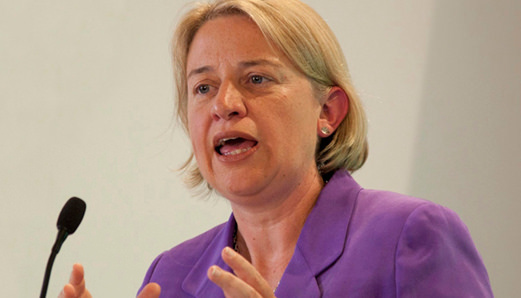 This article was first published here in the Green European Journal
This article was first published here in the Green European Journal
UPDATE: Ofcom’s decision not to give the Greens major party status this week led to nearly 300 people joining on the same day, bringing total UK-wide party membership to well over 40,000.
If they weren’t thriving before, 2014 put the UK’s Green Parties firmly on the map.
Amid a breakdown in public trust of the political mainstream, smaller parties have of course been on the rise. The growth of the hard right UKIP is well known, fuelled by big donors, ex-Conservative defectors and a fawning press. But the Greens have seen their own surge – partly in response – both in Scotland and in England & Wales. Two separate parties with strong links, they each have their own reasons for entering the political arena – the independence campaign playing a huge role for the Scottish Greens, while the dismal unpopularity of an austerity-obsessed Labour party in the rest of the UK played its part too.
December saw several high-profile new members come into the Scottish party’s ranks, including Independent Member of the Scottish Parliament (MSP)John Wilson, following John Finnie MSP’s ‘defection’ in October. Both were previously in the governing SNP but differed with the party over issues such as NATO. In England and Wales, high profile figures are turning to the party too, including many former Liberal Democrats in light of a gap on the left of the political spectrum.
The developments in Scotland are important because they in effect bring the size of the Green group up to four, joining co-convener Patrick Harvie and Alison Johnstone MSP in Holyrood. Though both new recruits will remain officially Independent until standing as Greens in 2016, the party has nonetheless enjoyed an overnight surge in credibility.
Importantly, it adds to the massive momentum building up behind the Greens before and in the aftermath of the Scottish referendum on independence, after they formed a crucial pillar in the Yes campaign. In the run up to the #indyref, the Greens outflanked the SNP from the left and put up a strong grassroots campaign, both independently and as part of groups such as Radical Independence, a coalition of left-wing activists that saw over 3,000 gather for their post-referendum conference in November. The extent to which this built up the party’s prestige among the Scottish left cannot be understated.
In quantitative terms, these developments have seen the Scottish party’s membership surge from around 1,500 to nearly 8,000 since polls closed – more than quadrupling in size in just a couple of months. Many of the new recruits are energised, more socialist-inclined, and young – the latter being pivotal in a country where 16 and 17 year olds are soon to get a vote in ordinary elections (75% of them voted in the recent referendum).
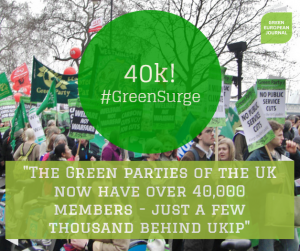 It’s not just the separate Scottish Green Party which is benefiting from a surge however – the Green Party of England and Wales more than doubled in size in 2014 to over 31,000 members. Adding the Scottish and Northern Irish Greens therefore puts the party just a few thousand behind UKIP (42,000) and the Liberal Democrats (44,000). If both can win MPs with that membership, in theory so could the Greens. The thousands more foot-soldiers for upcoming elections will be crucial for the years ahead, if the momentum can be sustained.
It’s not just the separate Scottish Green Party which is benefiting from a surge however – the Green Party of England and Wales more than doubled in size in 2014 to over 31,000 members. Adding the Scottish and Northern Irish Greens therefore puts the party just a few thousand behind UKIP (42,000) and the Liberal Democrats (44,000). If both can win MPs with that membership, in theory so could the Greens. The thousands more foot-soldiers for upcoming elections will be crucial for the years ahead, if the momentum can be sustained.
Explaining the rise is difficult however, as there are a huge number of factors. We can summarise some:
The rise of UKIP
- The Green Party’s growth correlates to a certain extent with anti-UKIP sentiment – as UKIP grows, the need for a progressive response to it does too, pushing greens of all shades into action. It’s a dialectical relationship that in some ways means UKIP’s worrying emergence could strengthen the Greens, at least in the short-term – although it is arguably an unstable basis for success.
The sorry state of the Labour Party
- In Scotland this was seen through the recent dramatic resignation of the leader Johann Lamont, who said the Scottish Labour Party was run as a ‘branch office’ of Ed Miliband’s Westminster party. In a nation as independent-thinking as Scotland, it was an insult of the worst kind – and has seen Labour’s poll share plummet (mostly, admittedly, to the SNP’s benefit). It’s an opportunity for the Greens too, however. And Labour’s dire situation is unlikely to change any time soon, after electing the Iraq war-supporting Jim Murphy to the leadership after Lamont’s exit.
- In the rest of the UK, Labour’s failure to challenge austerity, fracking and countless other social and environmental evils have seen a mass exodus of young support, putting the Greens on nearly 20% among ‘the youth’, much of it at Labour’s expense, as well as the Lib Dems whose tripling of tuition fees meant reneging on firm promises in 2010.
The ‘Media Blackout’ of the Greens
- Much publicised plans to exclude the Greens (as well as the SNP and left-wing Welsh nationalists Plaid Cymru) from next year’stelevised General Election debates have been a blessing in disguise for the party, with a petition against the plan reaching over nearly 300,000 signatures, while anger at the ‘BBC Blackout’ of the Greens during the European elections saw nearly 85,000 register their rage According to a recent poll, 79% of the public want to see the Greens on the TV debates, against Nigel Farage. Even Labour have been swayed by the pressure.
A self-perpetuating cycle
- As these factors piled up, Green support has further grown – leading to more coverage, more members, and more support. Polls now frequently put the party ahead of the discredited Lib Dems, while the party’s only MP, Brighton’s Caroline Lucas, has forged a10-point lead over Labour in her constituency. It shows that Greens can win, and can be popular, too.
A shift to the left
- 2014 has seen the Greens pitch themselves as a serious party of the left – consciously and openly. Not only has it won over thousands of former Liberal Democrat and Labour voters, it is the expression of a trend that has been in course for several years now. As such, it’s both a principled and pragmatic move, which when bolstered by progressive alliances with the SNP and Welsh nationalists Plaid Cymru, significantly contributes to the #GreenSurge.
2015 and beyond
All this is in addition to the Greens’ growing social media attention (#GreenSurge, and #InviteTheGreens for the TV debates, have frequently ‘trended’ on Twitter), as well as its rapidly expanding infrastructure in terms of staff and local branches across the UK as a whole.
Moreover, the Greens’ embrace of crowdfunding and small donations is bolstering these factors, and has the potential to lead to a democratisation and expansion of party funding in the UK –pitching the Greens as a party separate to big business.
What are the implications of these developments? Firstly, it could see more Greens elected next year, including Bristol’s Darren Hall. But given that in 2010 the Greens achieved just 1% of the vote, keeping hundreds of election deposits with a result of even 5% or more would be a breakthrough for the party on both sides of the border. After that, the Green surge could be unstoppable – going into the Scottish election in 2016 (where they’re set to win 10 MSPs) and beyond.
A difficult road ahead
The challenge, however, is to retain this energy and radicalism as the parties grow, internalising the thousands of new members and to not only elect more representatives, but more importantly to use this new dynamism to achieve real change – as it already is. Avoid the centralisation that institutionalisation and organisational growth can bring will pose difficulties for the Green movement, heightening pressures on internal democracy and through increased media scrutiny.
All the while, it must be remembered that the aim of increasing support isn’t for its own sake, but for making a real difference to people’s lives in Britain and beyond. Uniting with other progressive parties is and should continue to be part of this. That is why the Greens’ definite shift to the left in 2014 has been so central – the Greens are now the only major self-declared left-wing party.
There are major stumbling blocks however which shouldn’t be ignored. The electoral system is woefully unfair, meaning opportunities for large-scale seat gains are unlikely. The Greens still suffer a personality problem, with few voters knowing anyone other than Caroline Lucas or leader Natalie Bennett. And mainstream partisan debate appears to be shifting to the right the more that figures such as Farage fill the airwaves. There’s also still a huge psychological gap between the numbers who would support the Greens if they thought they could win, and those who would vote for them now – 26%would vote Green if they thought it was a ‘worthwhile’ vote. Breaking that psychological barrier has to be at the core of Green strategy in upcoming elections.
But there’s significant cause for hope. Something exciting is bubbling under the surface of British politics. The party system is breaking apart – ironically with the help of the enemy of the left, UKIP. People are becoming active in party politics again, finally inspired to engage with a previously discredited ‘formal’ politics.
If 2015 will be anything like how 2014 has been for the Greens, then it will be a good year indeed…

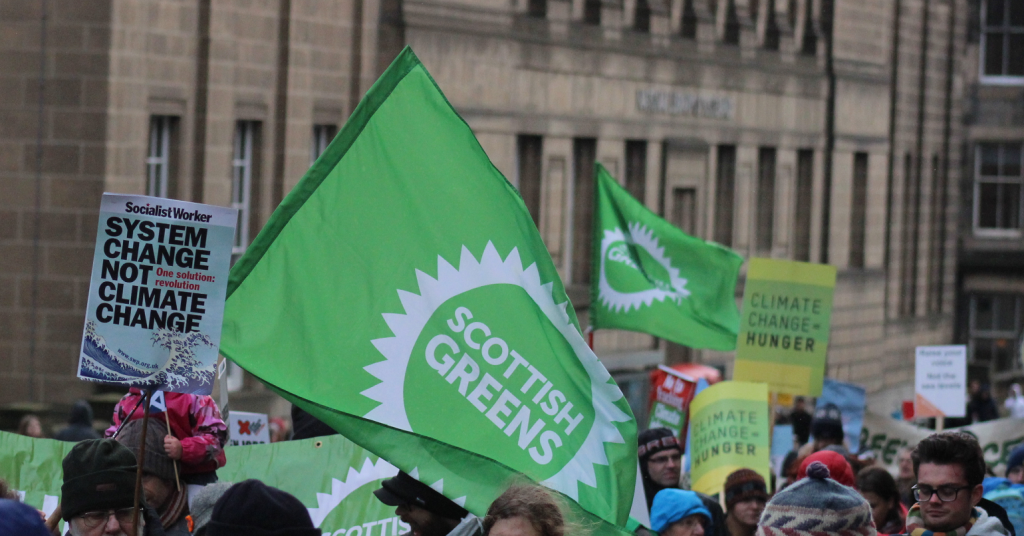
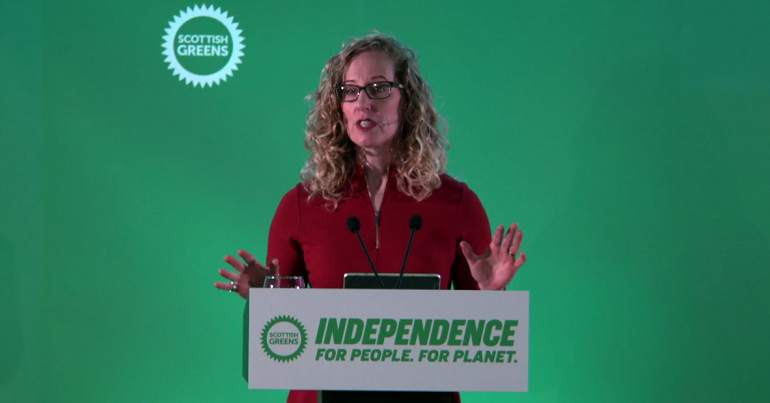
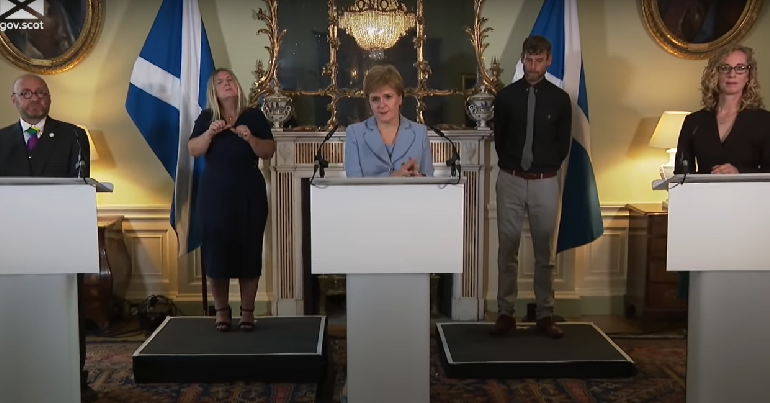
Sorry,1st word should be interesting
Iteresting article & I feel sure the Greens are headed for a real breakthrought I certainly hope so, I am 74 & have been an enthusiastic member since 1989 & could not envisage supporting any other as none are so honest & have policies to benefit MOST people, animals & the environement!
Actually they are not so left wing as people say but do care about the less fortunate & realise we are not all equal but all deserve a chance!